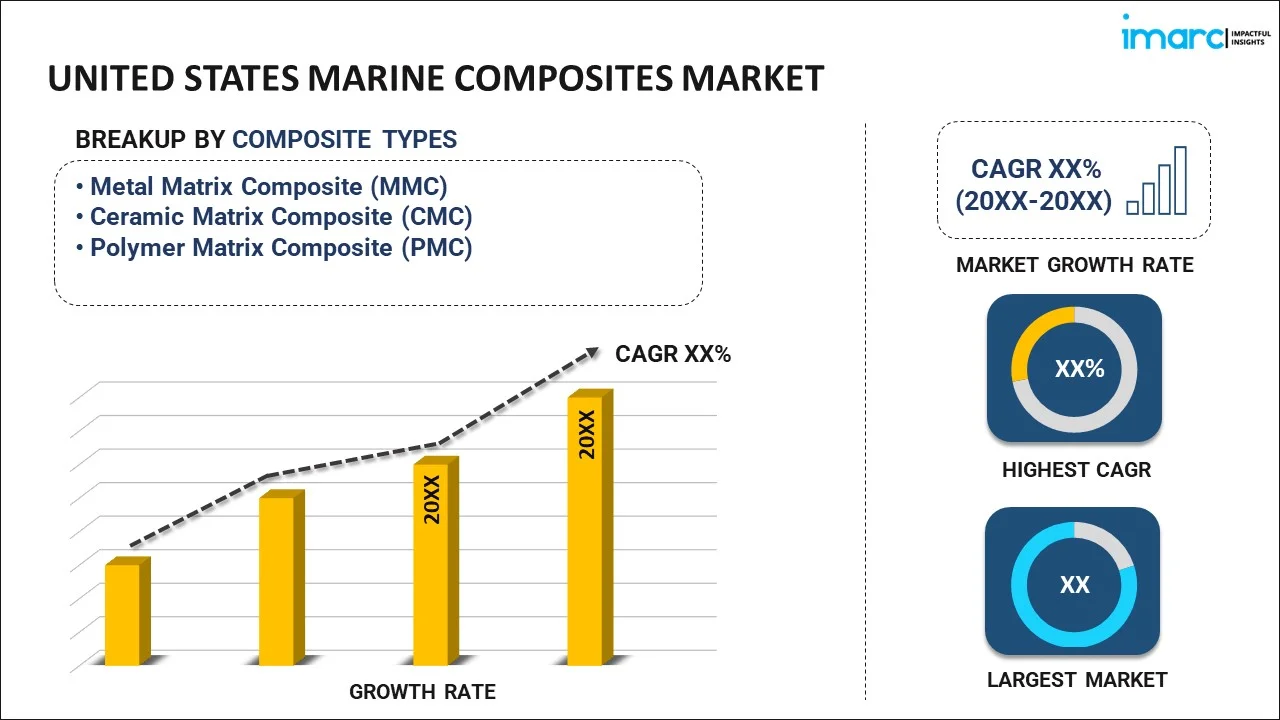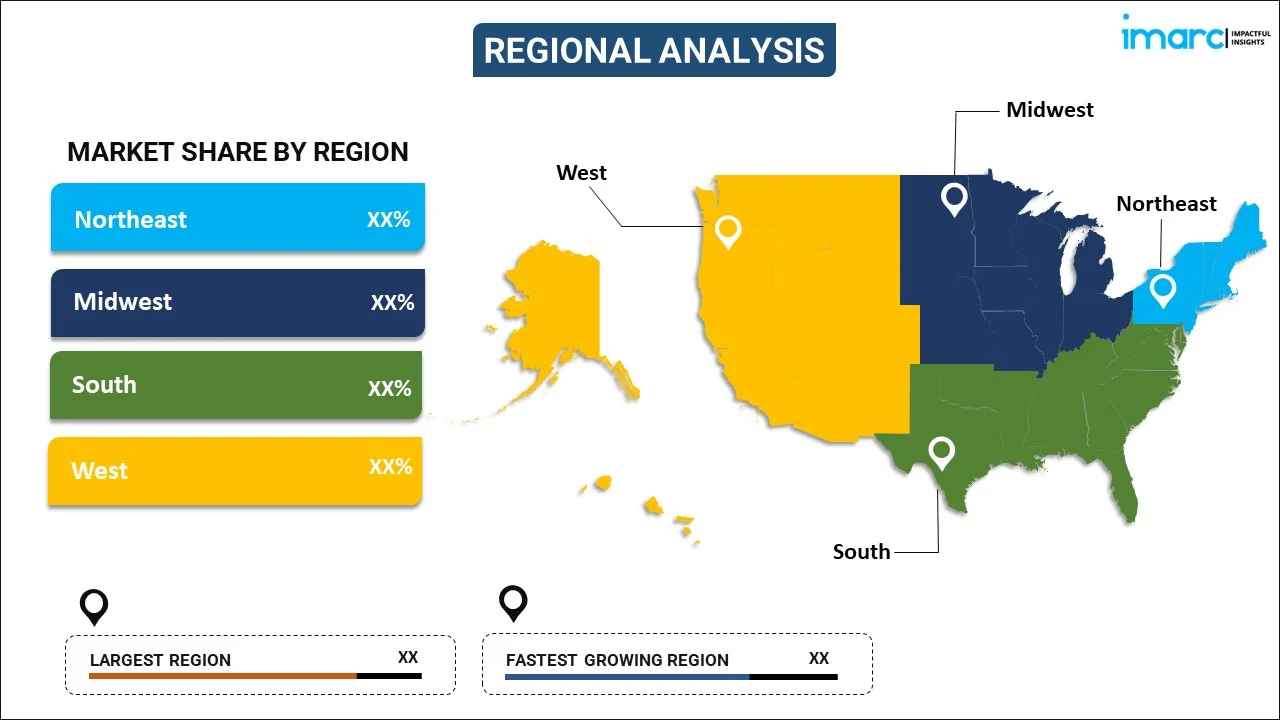
United States Marine Composites Market Report by Composite Type (Metal Matrix Composite (MMC), Ceramic Matrix Composite (CMC), Polymer Matrix Composite (PMC)), Fiber Type (Glass Fiber, Carbon Fiber, Aramid Fiber, Natural Fiber, and Others), Resin Type (Polyester, Vinyl Ester, Epoxy, Thermoplastic, Phenolic, Acrylic, and Others), Vessel Type (Power Boats, Sailboats, Cruise Ships, and Others), and Region 2025-2033
Market Overview:
The United States marine composites market size reached USD 964.3 Million in 2024. Looking forward, IMARC Group expects the market to reach USD 1,438.0 Million by 2033, exhibiting a growth rate (CAGR) of 4.31% during 2025-2033. Growing demand for lightweight and durable materials in boat building, the increasing need for fuel-efficient vessels, and the rising popularity of recreational boating and water sports activities are some of the key factors driving the market.
|
Report Attribute
|
Key Statistics
|
|---|---|
|
Base Year
|
2024
|
|
Forecast Years
|
2025-2033
|
|
Historical Years
|
2019-2024
|
|
Market Size in 2024
|
USD 964.3 Million |
|
Market Forecast in 2033
|
USD 1,438.0 Million |
| Market Growth Rate 2025-2033 | 4.31% |
Marine composites are materials used extensively in the construction of boats, yachts, and other marine structures. Its components typically include a matrix material and a reinforcing material. The matrix material is a resin, which serves as a binder for the reinforcing material. The reinforcing material is typically a fiber, such as a fiberglass, carbon fiber, or Kevlar. One of the key advantages of marine composites is their strength-to-weight ratio. They are much lighter than traditional materials, such as steel or aluminum, while being incredibly strong. They are also highly resistant to corrosion, durable, and require low maintenance. Consequently, boats and other marine structures made from composites are fast and fuel-efficient. Currently, there are umpteen variants available, including fiberglass, carbon fiber, and Kevlar composites.
United States Marine Composites Market Trends:
The growing demand for durable and lightweight materials in boat building and marine applications represents one of the key factors providing a positive outlook for the market. Another contributing driver is the increasing need for fuel-efficient vessels, which has led to the adoption of composite materials that offer improved strength-to-weight ratios. Additionally, the rising popularity of recreational boating and water sports activities and the expanding application scope of composites in various marine segments, such as naval vessels, luxury yachts, and commercial boats, are propelling the market growth. In line with this, the development of bio-based composites and the escalating adoption of composites in marine infrastructure are boosting the market growth. Furthermore, the favorable regulatory environment and government initiatives to promote the use of composite materials in marine applications are contributing to the market growth. Other factors, such as the availability of raw materials, the growing focus on renewable energy, and the presence of established manufacturers, are fueling the market growth.
Key Market Segmentation:
IMARC Group provides an analysis of the key trends in each sub-segment of the United States marine composites market report, along with forecasts at the country and regional level from 2025-2033. Our report has categorized the market based on composite type, fiber type, resin type and vessel type.
Composite Type Insights:

- Metal Matrix Composite (MMC)
- Ceramic Matrix Composite (CMC)
- Polymer Matrix Composite (PMC)
The report has provided a detailed breakup and analysis of the United States marine composites market based on the composite type. This includes metal matrix composite (MMC), ceramic matrix composite (CMC), and polymer matrix composite (PMC). According to the report, polymer matrix composite (PMC) accounted for the largest market share.
Fiber Type Insights:
- Glass Fiber
- Carbon Fiber
- Aramid Fiber
- Natural Fiber
- Others
The report has provided a detailed breakup and analysis of the United States marine composites market based on the fiber type. This includes glass fiber, carbon fiber, aramid fiber, natural fiber, and others. According to the report, glass fiber accounted for the largest market share.
Resin Type Insights:
- Polyester
- Vinyl Ester
- Epoxy
- Thermoplastic
- Phenolic
- Acrylic
- Others
The report has provided a detailed breakup and analysis of the United States marine composites market based on the resin type. This includes polyester, vinyl ester, epoxy, thermoplastic, phenolic, acrylic, and others. According to the report, polyester accounted for the largest market share.
Vessel Type Insights:
- Power Boats
- Sailboats
- Cruise Ships
- Others
The report has provided a detailed breakup and analysis of the United States marine composites market based on the vessel type. This includes power boats, sailboats, cruise ships, and others. According to the report, cruise ships accounted for the largest market share.
Regional Insights:

- Northeast
- Midwest
- South
- West
The report has also provided a comprehensive analysis of all the major regional markets, which include Northeast, Midwest, South, and West.
Competitive Landscape:
The report has also provided a comprehensive analysis of the competitive landscape in the United States marine composites market. Competitive analysis such as market structure, market share by key players, player positioning, top winning strategies, competitive dashboard, and company evaluation quadrant has been covered in the report. Also, detailed profiles of all major companies have been provided. For each of the companies covered, the report provides business overview, services offered, business strategies, financials, SWOT analysis, and major news and events.
Report Coverage:
| Report Features | Details |
|---|---|
| Base Year of the Analysis | 2024 |
| Historical Period | 2019-2024 |
| Forecast Period | 2025-2033 |
| Units | Million USD |
| Segment Coverage | Composite Type, Fiber Type, Resin Type, Vessel Type, Region |
| Region Covered | Northeast, Midwest, South, West |
| Customization Scope | 10% Free Customization |
| Post-Sale Analyst Support | 10-12 Weeks |
| Delivery Format | PDF and Excel through Email (We can also provide the editable version of the report in PPT/Word format on special request) |
Key Benefits for Stakeholders:
- IMARC’s report offers a comprehensive quantitative analysis of various market segments, historical and current market trends, market forecasts, and dynamics of the United States marine composites market from 2019-2033.
- The research study provides the latest information on the market drivers, challenges, and opportunities in the United States marine composites market.
- The study maps the leading, as well as the fastest-growing, regional markets. It further enables stakeholders to identify the key country-level markets within each region.
- Porter's five forces analysis assist stakeholders in assessing the impact of new entrants, competitive rivalry, supplier power, buyer power, and the threat of substitution. It helps stakeholders to analyze the level of competition within the United States marine composites industry and its attractiveness.
- Competitive landscape allows stakeholders to understand their competitive environment and provides an insight into the current positions of key players in the market.
Key Questions Answered in This Report
The United States marine composites market was valued at USD 964.3 Million in 2024.
We expect the United States marine composites market to exhibit a CAGR of 4.31% during 2025-2033.
The rising demand for marine composites to manufacture recreational boats, as they have high mechanical strength, fuel efficiency, reduction in the overall weight, corrosion resistance, and customizability, is primarily driving the United States marine composites market.
The sudden outbreak of the COVID-19 pandemic had led to the implementation of stringent lockdown regulations across the nation, resulting in the temporary halt in numerous production activities for marine composites.
Based on the composite type, the United States marine composites market has been segmented into Metal Matrix Composite (MMC), Ceramic Matrix Composite (CMC), and Polymer Matrix Composite (PMC). Among these, Polymer Matrix Composite (PMC) currently holds the majority of the total market share.
Based on the fiber type, the United States marine composites market can be divided into glass fiber, carbon fiber, aramid fiber, natural fiber, and others. Currently, glass fiber exhibits a clear dominance in the market.
Based on the resin type, the United States marine composites market has been categorized into polyester, vinyl ester, epoxy, thermoplastic, phenolic, acrylic, and others, where polyester currently accounts for the majority of the total market share.
Based on the vessel type, the United States marine composites market can be segregated into power boats, sailboats, cruise ships, and others. Currently, cruise ships hold the largest market share.
On a regional level, the market has been classified into Northeast, Midwest, South, and West.
Need more help?
- Speak to our experienced analysts for insights on the current market scenarios.
- Include additional segments and countries to customize the report as per your requirement.
- Gain an unparalleled competitive advantage in your domain by understanding how to utilize the report and positively impacting your operations and revenue.
- For further assistance, please connect with our analysts.

 Inquire Before Buying
Inquire Before Buying
 Speak to an Analyst
Speak to an Analyst
 Request Brochure
Request Brochure
 Request Customization
Request Customization



.webp)




.webp)












